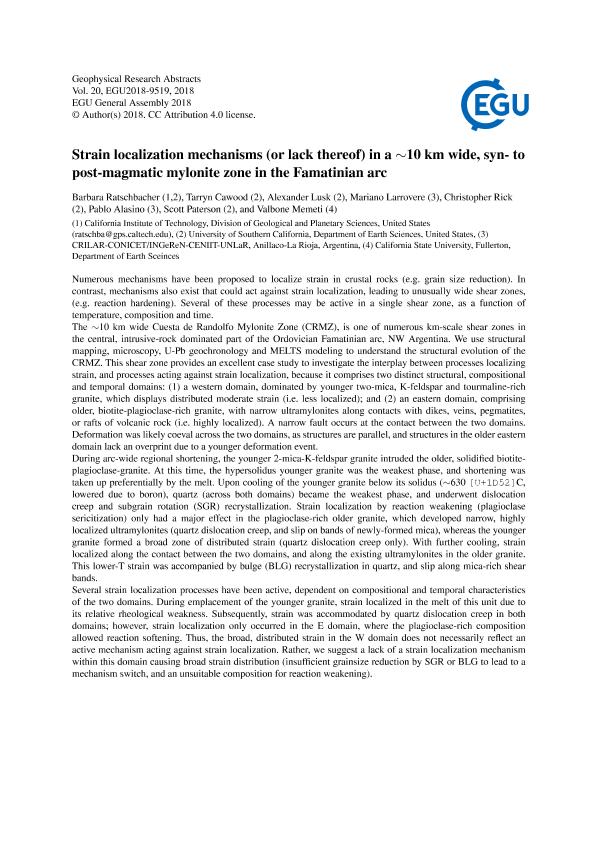Evento
Syn- to postmagmatic strain localization in the 10 km-wide cuesta de Randolfo Mylonite Zone, NW Argentina.
Cawood, Tarryn; Ratschbacher, Barbara; Lusk, Alexander; Larrovere, Mariano Alexis ; Rick, Christopher; Alasino, Pablo Horacio
; Rick, Christopher; Alasino, Pablo Horacio ; Paterson, Scott R.; Memeti, Valbone
; Paterson, Scott R.; Memeti, Valbone
 ; Rick, Christopher; Alasino, Pablo Horacio
; Rick, Christopher; Alasino, Pablo Horacio ; Paterson, Scott R.; Memeti, Valbone
; Paterson, Scott R.; Memeti, Valbone
Tipo del evento:
Reunión
Nombre del evento:
EGU General Assembly
Fecha del evento:
04/04/2018
Institución Organizadora:
European Geosciences Union;
Título de la revista:
Geophysical Research Abstracts
Editorial:
Copernicus Publications
Idioma:
Inglés
Clasificación temática:
Resumen
We provide the first modern description of the Cuesta de Randolfo shear zone based on a combination of field and thin section observations, geochemistry, and geochronology. We identify four structural domains, characterized by different intrusive units, structural styles and deformation mechanisms, and that record deformation at different temperatures. These domains reflect different processes of strain localization, active during continuous cooling, as a function of the mineralogy and protolith composition of the affected rocks: The earliest deformation occurred as hypersolidus flow in the melt phase of the youngest intrusive units (~ 460 Ma), followed by high-T major quartz and minor kfsp SGR recrystallization, leading to distributed moderately-intense strain (i.e. de-localized) and steep fabrics formed as this material was ? squeezed-out? across the entire emplacement area . Upon further cooling, strain finally localized in narrow thrust zones occurring at the contact between the two generations of intrusive units.The older plagioclase-rich intrusive unit (~ 480 Ma) did not experience shearing during emplacement and cooling through the solidus but developed narrow ultramylonitic zones caused by reaction weakening of plagioclase located at contacts to dikes, veins and pegmatites of the younger phases or rafts of metapelitic host (i.e. strongly localized strain) during the later, cooler deformation. As these wide and steep shear zones, characteristic of the central part of the Famatinian orogeny, primarily occur in peraluminous rocks, we hypothesize here that the characteristic mineralogy and composition unique to these rock types guides the strain (de-) localization throughout the central part of the Famatinian arc.
Palabras clave:
STRAIN LOCALIZATION
,
DUCTILE SHEAR ZONE
,
PUNA
,
ARGENTINA
Archivos asociados
Licencia
Identificadores
Colecciones
Eventos(CRILAR)
Eventos de CENTRO REGIONAL DE INV. CIENTIFICAS Y TRANSFERENCIA TECNOLOGICA DE ANILLACO
Eventos de CENTRO REGIONAL DE INV. CIENTIFICAS Y TRANSFERENCIA TECNOLOGICA DE ANILLACO
Citación
Syn- to postmagmatic strain localization in the 10 km-wide cuesta de Randolfo Mylonite Zone, NW Argentina.; EGU General Assembly; Viena; Austria; 2018; 1-1
Compartir



